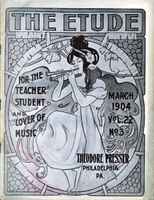J. H. A.—1. What stops are suitable to accompany tenors or basses in solo work as well as chorus work? Ditto, sopranos and altos.
Answer: For the high voices (soprano and tenor) in solo work, we would suggest for the soft passages the Stopped Diapason and Violina, Stopped Diapason and Flute, 4 feet, or Stopped Diapason and Salicional. For louder passages use the Swell Open Diapason with Flute, 4 feet, or add the Oboe to the above combinations. The Oboe with the Flute, 4 feet, or with the Stopped Diapason is useful with sustained harmony, if the singer is not singing too softly. As the accompaniment grows louder more volume is needed and all the 8 and 4 feet stops in the Swell should be used. If still louder, the full Swell, or the soft stops in the Great coupled to the Swell, and sometimes, though rarely, the Great Open Diapason is none too loud. The above combinations should be contrasted with others such as the Melodia with or without the Flute, 4 feet.
For the low voices in solo work, oftentimes the accompaniment is written too low for some of the above combinations and an 8 feet string or reed tone combined with a 4 feet flute tone is more satisfactory than when the 8 feet tone is flute tone only. So much depends on the power of the particular voice and the character of the accompaniment that it is difficult to give general suggestions.
In chorus work more volume is required, and sometimes one has to use a combination which is too loud to keep the voices up to the pitch. One must guard against using too loud pedal combinations when accompanying male or female voices separately. If the chorus is of mixed voices, more power in the bass part is not objectionable.
2. For accompanying a chorus of 300 voices what stops would you suggest?
Answer: For the forte passages at least all the 8 and 4 feet stops of the Great and Swell. If the full Swell is not too loud it may be added to the Great combinations. The pedal should be full in tone, but care must be exercised in using the Pedal Open Diapason as it oftentimes is much too loud for any passages except the climax. Again much depends on the voicing of the organ. Full organ is none too loud for forte passages in some organs where the organ is voiced soft, but in other organs the full Swell coupled to the 8 and 4 feet stops of the Great would be too loud. When the above chorus is singing softly the accompaniment could be played on the Swell with all 8 and 4 feet stops, including Oboe. If this combination is not strong enough the full Swell with the swell closed could be used. Another good combination for the softer passages is the Melodia, Flute, 4 feet, and Geigen Principal in the choir organ.
With a male chorus of thirty voices would the following pedal combination be too strong, viz.: Principal, 16 feet, Subbass, 16 feet, Octave, and Violone, 8 feet?
Answer: Unless the Principal (Open Diapason, 16 feet) is a very soft one it would be too much for the male chorus.
We can only repeat that so much depends on the voicing of the organ and the character of the accompaniment that it is well nigh impossible to even suggest suitable combinations with any degree of certainty.
Note.—Referring to the query in the January number relative to pedal pianos, a correspondent writes that she has used Pole's pedal attachment— which can be adjusted to any piano, square, upright, or grand—for five years and has found it highly satisfactory.
D. A. F.—I play an organ (with one manual) similar to the one described by Mr. Gibson in The Etude for January, except that mine has a Principal instead of a Salicional and for some reason the Tremolo has been removed. It would interest me to know the thirty-eight combinations that Mr. Gibson referred to but did not enumerate.
Answer: Perhaps Mr. Gibson will accommodate the questioner.
2. Can you tell me of any books describing the qualities of the different stops?
Answer: See Hinton's "Organ Construction" and Locker's "Organ Stops."
J. L. M. C.—Organ collections in addition to those which you name: "Organ Voluntaries," by various composers, published by Ditson; "Whitney's Organ Album," published by Ditson; "Twelve Pieces for the Organ," by Lemaigre, published by Schirmer; "Twelve Church Pieces," by Dunham, published by Schmidt; "One Hundred and Five Interludes," founded on favorite hymn tunes, by Hiles, published by Ditson.
St. Mary.—Through The Etude I would be grateful for an explanation of the difference between a pipe organ and a vocalion.
Answer: A vocalion is a species of a reed organ. The tone is produced by a reed, but instead of the wind being drawn through on the "exhaust" system it is forced through on the "inflating" system. A "resonator," or short pipe, is placed near the reed and modifies the tone so that much of the disagreeable "whine" is prevented. The fact that the "resonator" is a pipe should not give one an idea that the instrument is a pipe organ, as there is no resemblance to the pipe organ.



